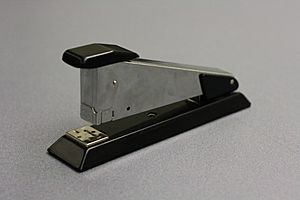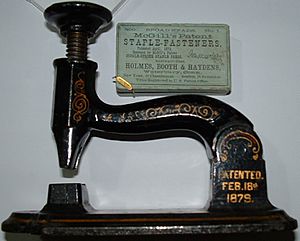Stapler facts for kids
A stapler is a tool that joins sheets of paper or similar materials. It works by pushing a thin metal staple through the pages. Then, it folds the ends of the staple. Staplers are used everywhere! You can find them in offices, workplaces, homes, and schools.
The word "stapler" can mean different tools. Besides joining paper, some staplers are used in hospitals. These surgical staplers help doctors join body tissues, like closing a wound after surgery. This is similar to how sutures (stitches) work.
Most staplers are for paper. There are two main types: manual and electric. Manual staplers are usually held by hand. Some manual staplers sit on a desk. Electric staplers come in many designs. They are great for joining many sheets of paper quickly. Some electric staplers can staple up to 20 sheets at once.
Contents
History of Staplers
In the 1800s, people started using a lot more paper. This meant they needed a good way to hold papers together.
In 1866, a man named George McGill created a small, bendable metal fastener. This was like an early version of today's staple. The next year, in 1867, he made a machine to push these fasteners into paper. He showed his invention at a big event in Philadelphia in 1876. Other people also worked on stapler ideas around this time. For example, C. H. Gould got a patent in England in 1868.
In 1877, Henry R. Heyl made a machine that could both push in and bend a staple in one step. Because of this, some people think he invented the modern stapler.
The first machine that could hold many staples at once came out in 1878.
On February 18, 1879, George McGill got another patent for his "McGill Single-Stroke Staple Press." This was the first stapler that sold well. It was quite heavy, weighing over two pounds. It used one large staple at a time. This stapler could go through several sheets of paper.
The word "stapler" was first used in a magazine ad in 1901. It described a machine that fastened papers with metal wire.
In the early 1900s, some tools were made that joined papers without metal clips. The Clipless Stand Machine would cut a small piece of paper. Then it folded and tucked it to hold pages together. Another tool, Bump's New Model Paper Fastener, used a similar method.
How Modern Staplers Work
In 1941, the most common type of paper stapler was invented. It was called the four-way paper stapler. This stapler was very versatile. You could use it to staple papers to wood or cardboard. You could also use it like pliers for bags. Or, you could use it the normal way for paper.
The part of the stapler that bends the staple is called the anvil. The anvil often has two settings. The first setting is the most common. It's called the reflexive or "permanent" setting. Here, the staple's legs fold inward, towards the middle. This is for papers you want to keep together for a long time.
If you turn the anvil 180 degrees, you get the sheer setting. This is also called the "temporary" setting. In this position, the staple's legs fold outward. This makes the staple easier to remove. However, most people don't use this setting much. Staple removers are more common. Some simple staplers today only have the permanent setting.
Modern staplers keep getting better. "Less-effort" staplers are easier to squeeze. They use smart designs to reduce how much force you need. These staplers are great for jobs where you staple a lot.
Some desktop staplers use "Flat Clinch" technology. With these, the staple legs go through the paper. Then, they are pressed completely flat against the paper. This makes your stapled papers stack much flatter. This saves space in files and binders.
How Staplers Join Papers
Permanent fastening is the most common way to staple. The stapler pushes the staple through the paper. Then, a small metal plate called an anvil bends the ends of the staple. Usually, the ends bend inward. On most staplers, you can turn or slide the anvil. This lets you choose between permanent stapling or pinning.
Pinning is for holding documents together temporarily. To pin, you slide or turn the anvil. This makes the staple ends bend outward instead of inward. The staple holds the papers, but it's easy to remove.
Tacking is used to attach things to surfaces. Think of putting a paper on a bulletin board or wall. A stapler that can tack has a base that folds back. This way, the staples go directly into the object. They don't fold against the anvil. It works a bit like a staple gun, but with less force.
Saddle staplers have a special V-shaped part. They are used to staple folded sheets. This helps you make booklets.
Stapleless staplers were invented in 1910. They don't use metal staples at all. Instead, they punch out a small flap of paper. Then, they weave it through a notch to hold the pages. Some newer ones crimp the pages together with metal teeth.
Surgical Staplers
Doctors use surgical staplers in hospitals. They can use them instead of sutures (stitches) to close skin wounds. They also use them during some surgeries to join parts of the body. A surgical stapler looks different from a paper stapler. It doesn't have an anvil. Surgical staples are usually shaped like an "M". When a doctor presses the stapler, it pushes the staple through the skin. The ends then bend to form a rectangle.
Surgical staplers are often used during operations on the bowels. These staplers often have a built-in knife. As the staples are put in, the knife cuts the tissue. This helps keep the area clean and free from germs. The staples are made from surgical steel. They usually come in sterile, single-use packages.
Related pages
Types
See also
 In Spanish: Grapadora para niños
In Spanish: Grapadora para niños









